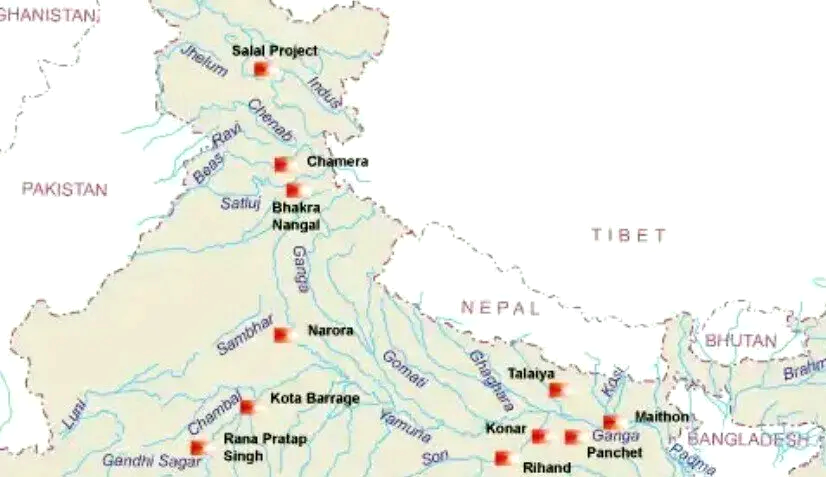Governance
Bhakra Beas Management Board (BBMB)
- 03 Mar 2022
- 6 min read
For Prelims: Bhakra Beas Management Board (BBMB), Bhakra Nangal Dam, Indus Water Treaty.
For Mains: Indus Water Treaty and related issues, Government Policies & Interventions.
Why in News?
Recently, the Central government has decided to adopt a new criterion for selecting members of the Bhakra Beas Management Board (BBMB).
What Changes have been made to the BBMB rules?
- A notification has been issued to amend the BBMB Rules 1974, thereby changing the criteria for the selection of whole-time members of the Board.
- As per the BBMB Rules, 1974, the member (power) in BBMB was from Punjab and the member (irrigation) was from Haryana but the requirement has been removed in the amended rules.
- New rules specify technical qualifications for the appointments and pave the way for appointment of the members from across India and not only Punjab and Haryana.
- The new rules have been opposed by the engineers’ fraternity, farmers as well as the political parties of Punjab.
- The engineers have pointed out that hardly any engineer would qualify for appointment as per the new specifications, which appear to be tailor-made for some personnel to be appointed from outside Punjab and Haryana.
- On the other hand, officials have argued that the changes have been made in pursuance to a judgement of the Punjab and Haryana High Court in the case of Jagmohan Singh Vs Union of India.
What is the Genesis of the BBMB?
- The genesis of BBMB lies in the Indus Water Treaty signed between India and Pakistan in 1960.
- Under the treaty, waters of three eastern rivers— Ravi, Beas and Sutlej — were allotted to India for exclusive use while Indus, Chenab and Jhelum rivers were allocated to Pakistan.
- In India, a master plan was drawn to harness the potential of these rivers for providing assured irrigation, power generation and flood control.
- Bhakra and Beas projects form a major part of this plan and were established as a joint venture of the then undivided Punjab and Rajasthan.
- Following the reorganisation of Punjab on 1st November 1966, and the creation of the state of Haryana, the Bhakra Management Board was constituted under Section 79 of the Punjab Reorganisation Act, 1966.
- The administration, maintenance and operation of Bhakra Nangal project was handed over to Bhakra Management on 1st October 1967.
- The Beas Project Works, on completion, were transferred from Beas Construction Board (BCB) to Bhakra Management Board as per the provisions of Section 80 of the Punjab Reorganisation Act, 1966.
- Pursuant to this Bhakra Management Board was renamed as Bhakra Beas Management Board (BBMB) w.e.f. 15th May 1976.
- Since then, BBMB regulates supply of water and power to Punjab, Haryana, Rajasthan, Himachal Pradesh, Delhi and Chandigarh.
What is the Constitution of the BBMB Management?
- It includes a chairperson and two whole time members who are from the partner states of Punjab and Haryana.
- They are designated as Member (Power) and Member (Irrigation) from Punjab and Haryana, respectively.
- There is representation from each member state including Rajasthan and Himachal Pradesh as nominated by the respective state governments.
- The total strength of BBMB is about 12,000 employees and out of these 696 are Group A officers and are posted from the partner states.
What is the Beas Project?
- The Beas-Satluj link scheme consists of a 76.2 m high rockfill diversion dam at Pondoh on Beas River in Mandi district (HP).
- Pong is a multipurpose earth & rockfill dam on Beas River, 40 km from Mukerian, Mukerian District, Himachal Pradesh. It is located in the Himalayan foot-hills downstream of Pandoh dam. BBMB commissioned the project in 1978-83.
What are the Features of the Bhakra Nangal Dam?
- Bhakra Dam is a concrete gravity dam across the Sutlej River and is near the border between Punjab and Himachal Pradesh in northern India.
- It is India’s second tallest at 225.55 m high next to the 261m Tehri Dam.
- Its reservoir, known as the “Gobind Sagar”, stores up to 9.34 billion cubic meters of water.
- Nangal dam is another dam downstream of Bhakra dam. Sometimes both the dams together are called Bhakra-Nangal dam though they are two separate dams.





